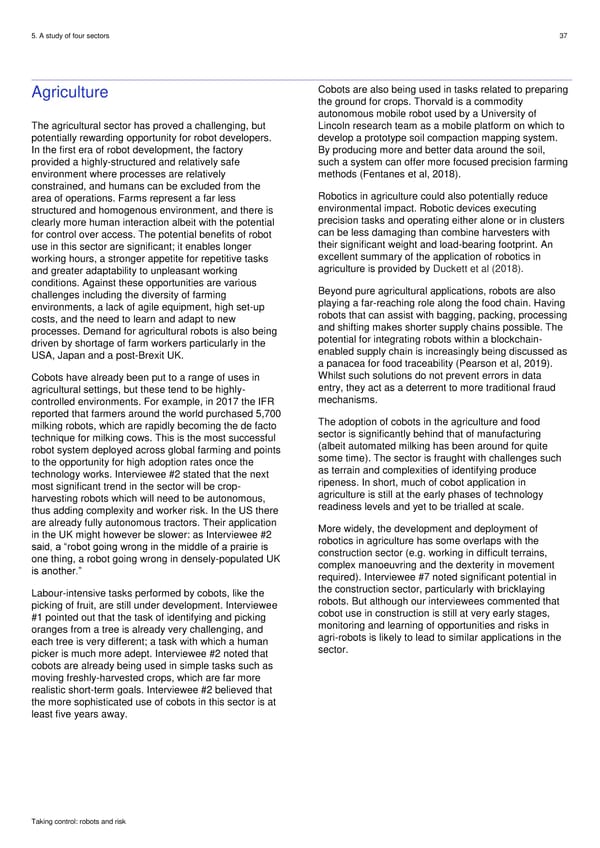5. A study of four sectors 37 Agriculture Cobots are also being used in tasks related to preparing the ground for crops. Thorvald is a commodity autonomous mobile robot used by a University of The agricultural sector has proved a challenging, but Lincoln research team as a mobile platform on which to potentially rewarding opportunity for robot developers. develop a prototype soil compaction mapping system. In the first era of robot development, the factory By producing more and better data around the soil, provided a highly-structured and relatively safe such a system can offer more focused precision farming environment where processes are relatively methods (Fentanes et al, 2018). constrained, and humans can be excluded from the Robotics in agriculture could also potentially reduce area of operations. Farms represent a far less environmental impact. Robotic devices executing structured and homogenous environment, and there is precision tasks and operating either alone or in clusters clearly more human interaction albeit with the potential can be less damaging than combine harvesters with for control over access. The potential benefits of robot their significant weight and load-bearing footprint. An use in this sector are significant; it enables longer excellent summary of the application of robotics in working hours, a stronger appetite for repetitive tasks agriculture is provided by Duckett et al (2018). and greater adaptability to unpleasant working conditions. Against these opportunities are various Beyond pure agricultural applications, robots are also challenges including the diversity of farming playing a far-reaching role along the food chain. Having environments, a lack of agile equipment, high set-up robots that can assist with bagging, packing, processing costs, and the need to learn and adapt to new and shifting makes shorter supply chains possible. The processes. Demand for agricultural robots is also being potential for integrating robots within a blockchain- driven by shortage of farm workers particularly in the enabled supply chain is increasingly being discussed as USA, Japan and a post-Brexit UK. a panacea for food traceability (Pearson et al, 2019). Cobots have already been put to a range of uses in Whilst such solutions do not prevent errors in data agricultural settings, but these tend to be highly- entry, they act as a deterrent to more traditional fraud controlled environments. For example, in 2017 the IFR mechanisms. reported that farmers around the world purchased 5,700 The adoption of cobots in the agriculture and food milking robots, which are rapidly becoming the de facto sector is significantly behind that of manufacturing technique for milking cows. This is the most successful (albeit automated milking has been around for quite robot system deployed across global farming and points some time). The sector is fraught with challenges such to the opportunity for high adoption rates once the as terrain and complexities of identifying produce technology works. Interviewee #2 stated that the next ripeness. In short, much of cobot application in most significant trend in the sector will be crop- agriculture is still at the early phases of technology harvesting robots which will need to be autonomous, readiness levels and yet to be trialled at scale. thus adding complexity and worker risk. In the US there are already fully autonomous tractors. Their application More widely, the development and deployment of in the UK might however be slower: as Interviewee #2 robotics in agriculture has some overlaps with the said, a “robot going wrong in the middle of a prairie is construction sector (e.g. working in difficult terrains, one thing, a robot going wrong in densely-populated UK complex manoeuvring and the dexterity in movement is another.” required). Interviewee #7 noted significant potential in Labour-intensive tasks performed by cobots, like the the construction sector, particularly with bricklaying picking of fruit, are still under development. Interviewee robots. But although our interviewees commented that #1 pointed out that the task of identifying and picking cobot use in construction is still at very early stages, oranges from a tree is already very challenging, and monitoring and learning of opportunities and risks in each tree is very different; a task with which a human agri-robots is likely to lead to similar applications in the picker is much more adept. Interviewee #2 noted that sector. cobots are already being used in simple tasks such as moving freshly-harvested crops, which are far more realistic short-term goals. Interviewee #2 believed that the more sophisticated use of cobots in this sector is at least five years away. Taking control: robots and risk
 Robots & Risk Page 36 Page 38
Robots & Risk Page 36 Page 38